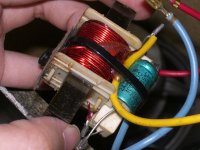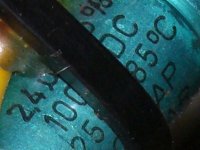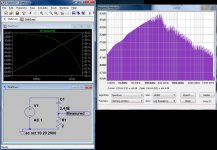I'm thinking my speakers sound weird so am thinking of replacing any electrolytic caps in crossover.
The high-pass filter is a 2R0 resistor in series with the green-blue 2.4uF capacitor. Or at least I think it says 2.4uF isn't it, and it can't be 24uF at that size and voltage.
So this is where I got suspicious. 2.4uF would result in a -3dB frequency that is too high if used with a say 8 + 2 ohm resistive load.
But what if the ESR of the capacitor came into play? Is this thing even electrolytic to start with?
I'm fearing worst case I might even ruin things by replacing it with a film cap.
Thanks in advance.
The high-pass filter is a 2R0 resistor in series with the green-blue 2.4uF capacitor. Or at least I think it says 2.4uF isn't it, and it can't be 24uF at that size and voltage.
So this is where I got suspicious. 2.4uF would result in a -3dB frequency that is too high if used with a say 8 + 2 ohm resistive load.
But what if the ESR of the capacitor came into play? Is this thing even electrolytic to start with?
I'm fearing worst case I might even ruin things by replacing it with a film cap.
Thanks in advance.
Attachments
Well, the ring on one end for outer wrap tend to indicate plastic film. If it was a speaker crossover and electrolytic, it would have to be non-polar electrolytic, which is hard to buy anymore. Film is so much smaller than it used to be. The non-polar electrolytics I do have, say "50 V NP" but marking practices vary.
I replaced a lot of <10 uf electrolytics in my organ with film and even ceramic, it sounds much better after than before. i don't recommend ceramic for crossover, the voltage swings are too high for the cap to act linear.
what 3 db point did you get? my Peavey woofer+horn speakers have a 1200 hz crossover frequency. If you have the manual for your speakers it might say what the crossover frequency is supposed to be.
If you have scope, you can run a sine wave sweep LP track (or file) through your power amp and determine what frequency these things are passing at- to determine if they are defective or not.
As speakers age, they also can develop cone problems (tears) or suspension problems with the rubber at the edge.
I replaced a lot of <10 uf electrolytics in my organ with film and even ceramic, it sounds much better after than before. i don't recommend ceramic for crossover, the voltage swings are too high for the cap to act linear.
what 3 db point did you get? my Peavey woofer+horn speakers have a 1200 hz crossover frequency. If you have the manual for your speakers it might say what the crossover frequency is supposed to be.
If you have scope, you can run a sine wave sweep LP track (or file) through your power amp and determine what frequency these things are passing at- to determine if they are defective or not.
As speakers age, they also can develop cone problems (tears) or suspension problems with the rubber at the edge.
Last edited:
The fact that it says 85C means it's certainly an electrolytic. I've never seen an NP electrolytic that wasn't marked NP. Are these good speakers? Maybe they used a regular cap and that's why its sounding bad! Try changing it to film. If it sounds a bit bright, start putting some resistance in series with the film cap.
You can always replace the cap and if the new cap doesn't improve the sound, put the original cap back.
I've seen lots of speakers with electrolytic caps in the crossover networks. Electrolytics do not work well in that service. They will certainly increase the distortion.
The 2.4uf value may have been chosen because the high frequency speaker does not have an 8 ohm impedance in the high frequency range. The capacitor's ESR will certainly have an effect on the performance.
If you can measure the actual impedance at some high frequency, you will get a better idea of the speaker's performance.
I've seen lots of speakers with electrolytic caps in the crossover networks. Electrolytics do not work well in that service. They will certainly increase the distortion.
The 2.4uf value may have been chosen because the high frequency speaker does not have an 8 ohm impedance in the high frequency range. The capacitor's ESR will certainly have an effect on the performance.
If you can measure the actual impedance at some high frequency, you will get a better idea of the speaker's performance.
Without owning real measuring equipment I have to make do with this
I'm guessing the downward slope towards the right is due to the capacitor's increasing ESR at higher frequencies?
Guess the only way to really know is to do the actual replacement. Thanks for the pointers on replacing.
I'm guessing the downward slope towards the right is due to the capacitor's increasing ESR at higher frequencies?
Guess the only way to really know is to do the actual replacement. Thanks for the pointers on replacing.
Attachments
- Status
- Not open for further replies.


